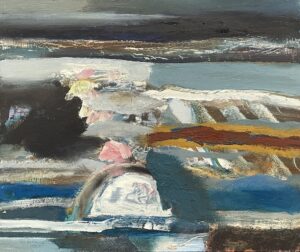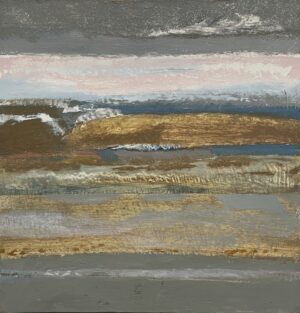Derek Hyatt
Derek Hyatt was an artist who shunned the London limelight, preferring instead to immerse himself, personally, psychologically and artistically, in the North Yorkshire landscapes which had first inspired his creativity. Originating from Ilkley, he studied at Leeds College of Art before gaining a scholarship to the Royal College of Art where he was awarded the prestigious Royal Scholar prize.
Hyatt enjoyed a varied and successful lecturing career, both in the UK and internationally, before returning to his roots and taking up an academic tenure in Leeds. Relocation to Yorkshire allowed him the opportunity to absorb himself once more in the bleak and harsh beauty of his native wolds, and in the process intentionally distance himself from the mainstream and fashionable artistic movements.
The use of perspective, shape and form in Hyatt’s painting contains echoes of Peter Lanyon’s work but yet it succeeds in retaining its own unique sense of mystery and symbolism, the artist imbuing the landscapes he depicts with an honest and authentic distinctiveness. Allied to a luxurious eye for colour, a legacy of the influence of Fauve artists such as Derain and de Vlaminck in his formative years, his semi-abstracted scenes suggest a deeper and more ethereal relationship with nature which transcend any merely topographical categorisation.
The paintings of Derek Hyatt have been exhibited widely in solo shows across the United Kingdom and he was described by the distinguished critic Peter Fuller as one of Britain’s finest painters. He was made a companions of the Guild of St George, the charity founded by John Ruskin, in 1990 and his work is held by many significant corporate and public collections including: Oxford, Leeds and Harvard universities; the New York Museum of Modern Art and the Financial Times.



